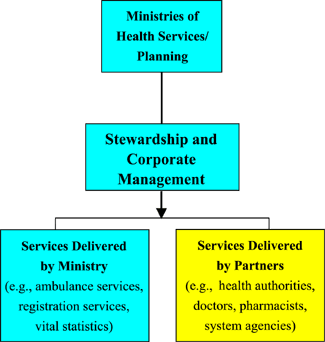|
 |
 |
2003/04 – 2005/06 SERVICE
PLAN
Ministry of Health Services |
 |
 |
Highlights and Changes from
Previous Plan
The 2003/04 to 2005/06 service plans clarify the ministries' and
their system partners' respective roles and responsibilities in
creating a responsive and well-managed patient-centred health system.
Specifically, the plan distinguishes between the role of our service
partners — health authorities, doctors and others —
who deliver the majority of health services to the public, and the
role of the ministries, which mainly provide stewardship and corporate
management in support of these health services.
This distinction is reflected in the organization of this year's
service plans around three refined core businesses: Services Delivered
by Partners, Services Delivered by Ministry, and Stewardship and
Corporate Management. "Services Delivered by Partners" is included
as a ministry core business because the ministry retains ultimate
responsibility for the health care system.
Core Businesses for the Ministries of Health

The ministries' primary function is stewardship over the health
care system. We provide direction and support to our partners, and
monitor and evaluate the impact of services delivered to the public.
To be good stewards, we must also provide good corporate management
to ensure that our own administration is run as efficiently and
effectively as possible. The two ministries also have a role in
providing services directly to the public, such as the BC Ambulance
Service, BC Vital Statistics, and Medical Services Plan registration.
Combined, the two health ministry service plans outline 46 strategies
for the next three years. The ministries have identified 15 of these
strategies as priorities, calling them 'Priority Strategies', to
signal their importance in guiding services delivered directly to
the public. Thirteen of these relate to services delivered by partners
and two to services delivered by the Ministry of Health Services.
These are detailed in the Ministry of Health Services service plan
but are also referenced in the introduction section of the Ministry
of Health Planning service plan.
The 15 priority strategies are:
- Prevent hospital admissions through primary care and community
options
- Provide post-acute (hospital) alternatives
- Manage acute care needs in hospital
- Provide alternatives to institutional care
- Build integrated care networks
- Improve care for people with extensive care needs
- Improve care for people with chronic conditions
- Improve care for the dying
- Improve the health status of Aboriginal peoples
- Enhance self-care and self-management
- Prevent disease and injury
- Enhance service quality for rural and smaller communities
- Manage within budget allocation
- Improve integration of the provincial ambulance service within
the overall health system
- Improve registration services to the public.
These 15 priority strategies support five key objectives for the
health care system over the next three years.
- Provide care at the appropriate level in the appropriate setting
by shifting the mix of acute/institutional care in favor of more
home/community care.
- Provide tailored care for key segments of the population to
better address their specific health care needs and improve their
quality of life.
- Keep people as healthy as possible by preventing disease, illness
and disability and slowing the progression of chronic illness
to minimize suffering and reduce care costs in the future.
- Manage within the available budget while meeting the priority
needs of the population.
- Provide clients with equitable and timely access to services
directly delivered by the ministry.
These key objectives and priority strategies for the health system
have been closely aligned with budget spending priorities for the
next three years and are reflected in the performance agreements
between the ministry and the health authorities.
The health ministries service plans also identify 28 strategies
specific to the ministries' respective stewardship and corporate
management roles. These are designed to support health partners
in achieving the 15 priority strategies. Finally, there are an additional
3 strategies, specific to the Vital Statistics Agency, listed under
services delivered by the Ministry of Health Planning.
To ensure results are monitored and evaluated, the plan also outlines
a series of key performance measures that are tied to the strategies.
Some have been carried forward from last year. Others were revised
to eliminate duplication with measures reported more appropriately
under other health annual reports such as those for the Provincial
Health Officer and Vital Statistics Agency.
As a result of these significant changes, this service plan now
better reflects key health system priorities for 2003/04 to 2005/06,
which are underlined in ministry budgets and health authority performance
agreements.
|
